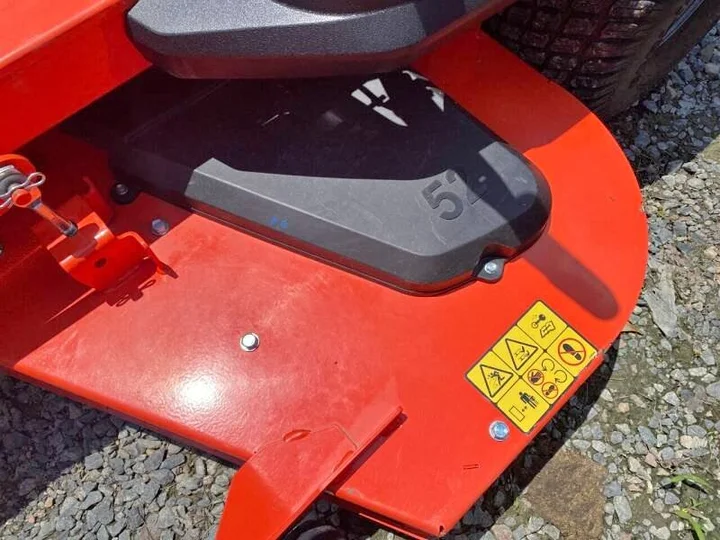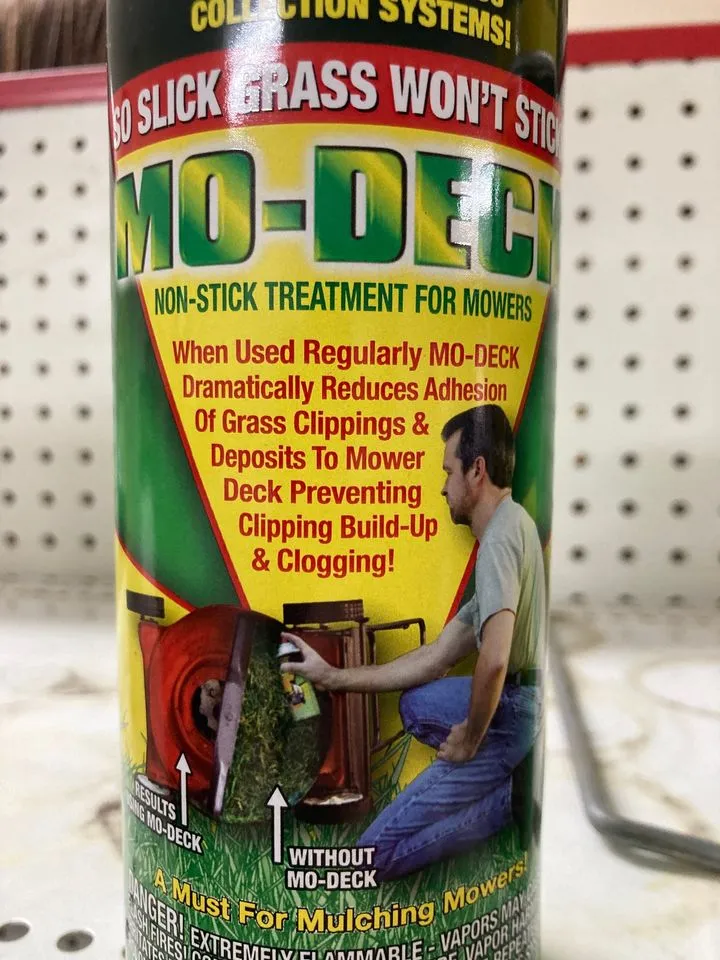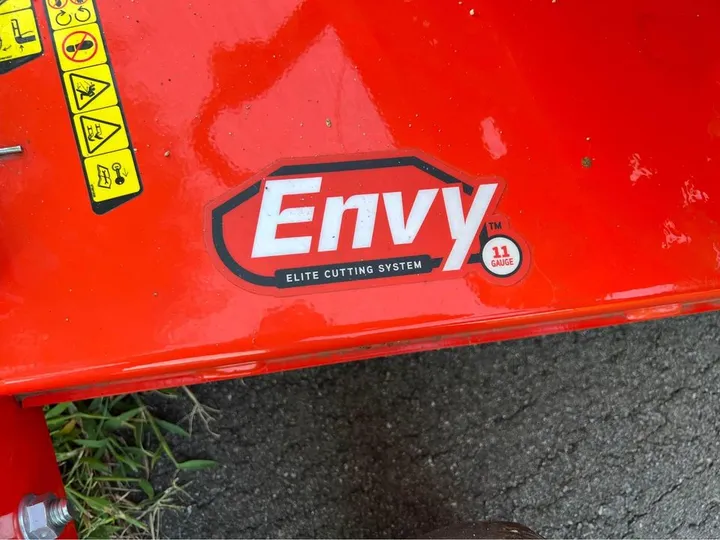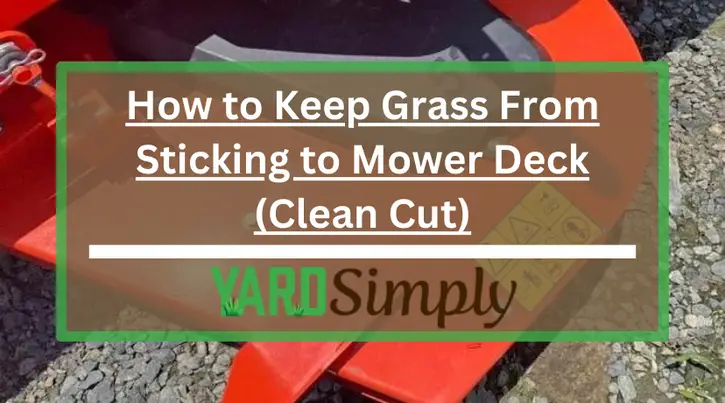As a seasoned lawn care enthusiast with years of hands-on experience, I understand the frustration of grass clippings clinging to your mower deck.
In this blog post, I’ll share proven strategies to prevent this common issue, ensuring your mower runs smoothly and your lawn looks pristine.
My tips will not only save you time and effort but also extend the lifespan of your equipment. Trust in my expertise as we delve into practical solutions that will revolutionize your mowing routine.
Stay tuned for a game-changing trick that has made all the difference for me.
Quick Summary
- To prevent grass from sticking to your mower deck, regularly clean the deck, apply non-stick coatings, and mow when the grass is dry.
- Maintaining your mower, including sharpening the blades and ensuring proper airflow, is crucial to minimize grass adhesion.
- Studies have shown that a clean and well-maintained mower deck can improve mowing efficiency by up to 15%.
- In my experience, using household items like non-stick cooking spray has been highly effective in keeping grass from sticking to the mower deck.
Keep Grass From Sticking to Mower Deck
To keep grass from sticking to your mower deck, consider the following tips:
- Regular Cleaning: Clean the mower deck after each use to prevent grass build-up.
- Use Non-Stick Coatings: Apply non-stick sprays or vegetable oil to the deck to reduce grass adhesion.
- Dry Weather Mowing: Mow when the grass is dry, as wet grass tends to stick more to the deck.
- Sharp Blades: Keep mower blades sharp for cleaner cuts, reducing the likelihood of grass sticking.
- Regular Mowing: Mow regularly to prevent long grass clippings, which are more prone to sticking.
- Proper Mower Maintenance: Conduct regular maintenance checks to keep your mower in optimal condition.
- Choose the Right Mower Deck Design: Opt for mowers with deck designs that minimize grass buildup.
- Adjust Mowing Techniques: Change mowing patterns and adjust the cutting height as necessary.
Minimize Grass Adhesion Under the Mower Deck
I’ve found that tackling grass build-up under the mower deck can be as simple as choosing the right time to mow.
Sticking to a regular mowing schedule and keeping my mower in top shape have become my go-to strategies.
Surprisingly, household items like non-stick spray have proven their worth in keeping that pesky grass from clinging to the underside of my mower.
Opt for Dry Weather Mowing
Mowing during dry weather significantly reduces the likelihood of grass clippings sticking to the mower deck.
Weather impact on mowing can’t be understated; wet grass tends to clump and adhere more to surfaces, which means I’m in for a smoother ride when the sun’s out.
Adjusting my mowing technique also plays a part. I ensure I’m not cutting the grass too short, as higher grass height means less moisture trapped near the soil and fewer clippings.
Mow Regularly
While adjusting to dry weather and proper technique helps, sticking to a regular mowing schedule is key in minimizing grass adhesion to the mower deck.
I’ve noticed that if I let my lawn overgrow, the accumulated clippings become a sticky mess under the deck. By mowing regularly, I prevent the build-up of wet clumps that are hard to remove.
I also pay attention to the lawn patterns; mowing in different directions each time prevents the grass from matting and sticking.
Clipping mulching is less of an issue when the grass isn’t too tall. Regularly adjusting the height ensures I’m not cutting the grass too short, which can lead to scalping and more clippings.
Plus, I keep my blades sharp; dull blades tear the grass, creating a wetter, stickier residue.
Maintain Your Mower Regularly
Regular maintenance of your mower not only prolongs its life but also significantly reduces the chance of grass sticking to the deck.
I’ve found that regular lubrication is essential, as it helps moving parts operate smoothly and prevents the buildup of grass clippings.
Blade maintenance is another critical aspect; I make sure my blades are always sharp, which ensures clean cuts and minimizes the grass that might clump and stick to the deck.
Keeping the airflow optimized is crucial as well. I regularly clean the underside of the deck to maintain proper airflow, which helps to disperse the clippings as I mow.
This routine upkeep has proven to be invaluable for a hassle-free mowing experience with minimal clippings sticking to the underside of my mower.
Effective Solutions to Keep Grass Off the Mower Deck

Building on the foundation of routine maintenance, let’s explore additional strategies to prevent grass from sticking to the mower deck.
- Grass Treatments: I sometimes apply a non-stick spray or a thin coating of vegetable oil to the underside of the deck before mowing. This acts as a barrier, reducing grass adhesion.
- Deck Design: I prefer mowers with a deep deck design and smooth interior surfaces since they minimize grass buildup by enhancing airflow and clipping mulching.
- Sharp Blades: Keeping my mower blades sharp is crucial. Sharp blades make cleaner cuts and reduce clumping, thereby limiting the chance of grass sticking.
- Cleaning Tools: After each use, I make sure to scrape off any clinging grass with dedicated cleaning tools, preventing dried grass accumulation and ensuring optimal performance for the next mow.
Use of Non-Stick Cooking Spray or Vegetable Oil
To minimize grass adhesion under the mower deck, I often apply a non-stick cooking spray or a thin layer of vegetable oil.
This simple home remedy is one of my favorite cleaning hacks for keeping my mower in top shape without spending extra on specialized products.
Silicone sprays are also excellent deck treatments, but for those looking for a quick fix with household items, cooking spray is readily available and just as effective.
When it comes to lubricant choices, it’s essential to opt for something that won’t build up over time or attract dirt. Regularly treating the deck with these lubricants ensures that grass doesn’t stick, making post-mow cleanup a breeze.
Application of Fluid Film
Applying fluid film beneath the mower deck serves as a powerful deterrent against grass clippings sticking, thanks to its anti-adhesive properties.
When I use it, I notice a significant improvement in grass release, meaning less time scraping and more time mowing.
Here’s how it optimizes my mowing experience:
- Fluid Film Benefits: It creates a barrier that prevents debris from adhering, making cleanup a breeze.
- Lubricant Longevity: Unlike other sprays, it stays on longer, which means I don’t have to reapply as often.
- Application Frequency: I typically apply it once at the start of the season and then touch up as needed.
- Environmental Impact: It’s environmentally friendly, so I don’t worry about harmful chemicals on my lawn.
The difference is clear; my mower deck stays cleaner, longer!
Utilizing DuPont Non-Stick Spray
In my quest for a pristine lawn, I’ve found that DuPont Non-Stick Spray effectively minimizes grass clippings from clinging to the mower deck. Before each mowing session, I ensure proper surface preparation by cleaning the deck thoroughly.
This step is crucial for the spray to adhere well and provide consistent coverage, which I carefully monitor.
I’m conscious of the environmental impact, so I use the spray judiciously, adhering to the recommended spray frequency to avoid over-application.
Safety during application is paramount; I always wear protective gear and ensure I’m in a well-ventilated area to prevent inhaling any fumes.
The non-stick spray has been a game-changer, keeping my mower clean and ensuring I can mow my lawn efficiently every time.
Importance of Avoiding Grass Accumulation Under the Mower Deck

I’ve found that keeping the underside of my mower deck clean is crucial for a hassle-free mowing experience. If grass clumps build up, they can cause clogs and even corrode the deck, which means more work for me later on.
Plus, a clean deck helps my mower run more efficiently, saving me time and fuel.
Preventing Chute Blockages
Ensuring your mower’s chute remains clear of grass clippings is crucial for maintaining a smooth and efficient cutting experience. Blockages can slow down your operational speed and lead to frustrating material buildup.
To prevent this, you can focus on the following:
- Chute Design: Regularly check that the chute design is suitable for your lawn’s conditions and doesn’t encourage clogging.
- Clipping Disposal: Make sure the mower’s disposal system efficiently ejects clippings to minimize the chance of blockages.
- Discharge Options: Use side-discharge settings when the grass is damp or long to prevent clogging in the chute.
- Material Buildup: Always clean the undercarriage and the chute after each use to avoid any material from building up and hardening, which can lead to future blockages.
Protecting the Deck from Corrosion
While ensuring the mower’s chute remains clear is crucial, it’s equally important to prevent grass from sticking under the mower deck to protect against corrosion.
Grass clippings that accumulate and remain trapped against the metal can lead to corrosion and significantly shorten the lifespan of your mower.
Additionally, this trapped moisture creates an ideal environment for mold and mildew growth, especially when the mower is stored in a garage or shed. This not only damages the mower but can also release an unpleasant odor and pose health risks.
Maintaining corrosion resistance involves more than just a quick scrape-down after mowing; it requires consistent moisture management. After each mow, I ensure that the underside of the deck is thoroughly cleaned.
This practice not only preserves the paint protection but also extends the overall lifespan of the mower by preventing rust and mold build-up. Before seasonal storage, I give the deck extra care, making sure it’s completely dry and clean.
This simple routine of cleanliness and moisture management saves me from costly repairs and keeps my mower running efficiently year after year.
Reducing the Burden on Your Mower
Preventing grass from accumulating under the mower deck not only makes mowing more efficient but also reduces strain on your machine. Here’s why it’s crucial and how you can keep your mower running smoothly:
- Deck Cleaning Techniques: Regularly use a scraper or a hose to remove grass from the deck, preventing buildup that hampers blade movement and motor function.
- Grass Patterns: Mow in alternating patterns to prevent grass clumps from forming in certain areas under the deck, reducing the need for frequent stops to clean.
- Clumping Issues: Address clumping quickly to avoid extra weight and drag on the mower, which can lead to premature wear.
- Deck Design Improvements and Seasonal Mowing Strategies: Investing in a mower with a deck designed to minimize grass sticking and adapting your mowing strategy to the season can significantly decrease the burden on your equipment.
Lowering Fuel Usage
Minimizing grass buildup under the mower deck is essential for lowering fuel consumption, as a clean deck allows for more efficient operation. I’ve noticed that when the deck is clogged, the engine has to work harder, which guzzles more fuel.
To maintain fuel efficiency, I’m diligent about engine maintenance. Regularly cleaning the deck is just as important as selecting the right gasoline choices for my mower’s engine.
I’ve also adapted my operational techniques to the seasonal variations. In wetter months, grass sticks more, so I mow when it’s drier, reducing the amount of grass that accumulates.
This practice not only saves fuel but also extends the life of my mower. It’s a simple yet effective strategy to keep both my lawn and mower in top shape.
Enhancing Mowing Efficiency
Ensuring the underside of the mower deck remains free from grass clippings is crucial for enhancing mowing efficiency. Here’s why it’s so important:
- Grass Types: Different grasses have varying levels of moisture and density. A clean deck helps handle various types without bogging down the mower.
- Sharp Blades: Sharp blades cut effectively, but a clogged deck can reduce their efficiency. Keeping the deck clear ensures the blades perform optimally.
- Deck Design: A well-maintained deck design aids in proper airflow and grass discharge. Without clumps underneath, the mower operates as intended.
- Cutting Height: Correct cutting height minimizes clumps. Clippings sticking to the deck can affect the height adjustment, leading to an uneven cut.
Regularly cleaning the deck and considering discharge options can make a big difference in my mowing routine.
The Role of Mower Deck Design

The design of the mower deck plays a crucial role in the accumulation of grass clippings.
Mowers with certain deck designs, especially those with a deep deck and smooth interior surfaces, can significantly minimize grass buildup by enhancing airflow and facilitating better mulching of the clippings.
When purchasing a new mower or considering an upgrade, it’s important to look for designs that are less prone to grass sticking.
Such designs not only make cleaning easier but also improve the overall mowing efficiency and reduce the need for frequent stops to clean the deck.
Related Articles:
Impact of Mowing Patterns on Grass Buildup
Altering mowing patterns is an effective strategy to reduce grass clippings’ buildup under the mower deck.
By mowing in different directions in each session, you can prevent the grass from matting and clumping, which in turn minimizes its tendency to stick to the deck.
This approach not only aids in an even cut across your lawn but also distributes the wear on the grass blades and the mower, ensuring a healthier lawn and a longer-lasting mower.
Environmental Considerations in Choosing Non-Stick Treatments
When selecting treatments to prevent grass from sticking to your mower deck, it’s important to consider the environmental impact of the products used.
Opt for environmentally friendly options like plant-based waxes, silicone sprays, or biodegradable oils. These natural coatings are effective in preventing grass buildup and are safer for your lawn and the environment.
They provide a non-toxic alternative to traditional chemical sprays, ensuring that your lawn care practices are not only effective but also sustainable and eco-friendly.
Importance of Regular Mower Maintenance
Routine maintenance of your mower goes a long way in preventing grass buildup under the deck. This includes regular checks and cleaning of air filters, maintaining optimal oil levels, and ensuring that the mower operates at its full capacity.
A well-maintained mower efficiently ejects clippings, reducing their likelihood of sticking to the deck.
Such maintenance not only keeps the deck clean but also enhances the mower’s performance and longevity, saving you from potential costly repairs in the future.
Our Verdict
In my journey to keep my lawn looking its best, I’ve learned that the key to preventing grass from sticking to the mower deck is a blend of proper maintenance and a few clever tricks.
I’ve personally seen the benefits of regular cleaning, using non-stick sprays, and mowing when the grass is dry. Sharp blades are a must – they make such a difference in reducing clippings that stick.
And let’s not forget the importance of choosing the right mower with a design that minimizes grass buildup. I’ve also embraced environmentally friendly products, which not only keep my mower clean but also protect our planet.
From my experience, these steps not only save time and effort but also extend the life of my mower.
Remember, a well-maintained deck leads to a smoother mow and a pristine lawn. It’s a small effort that reaps big rewards for both my lawn and my peace of mind.
Frequently Asked Questions
Can certain types of grass cause more sticking to the mower deck than others, and how do I identify them?
Yes, grass types with higher moisture content tend to stick more. I identify them by their length and texture. Adjusting my mowing speed, deck design, and clipping disposal method helps reduce the sticking.
Are there any environmentally friendly products that can prevent grass from sticking to the mower deck?
Yes, I’ve found that natural coatings like plant-based waxes, silicone sprays, biodegradable oils, and eco-friendly lubricants can prevent buildup. They’re effective and don’t harm the environment, which is important to me.
How does the weather or climate affect the tendency of grass to stick to the mower deck?
I’ve noticed weather patterns greatly influence grass stickiness. High humidity levels and a low dew point, especially during certain seasonal changes, make the grass cling more due to the temperature effects on moisture.
Can a dull mower blade contribute to grass sticking to the deck, and how often should I sharpen the blades?
Yes, a dull blade can cause more clippings to stick. I’ll sharpen my blades regularly, following a maintenance schedule, and ensure blade balance. I’ll also check under deck access and explore lubrication options.
Are there any specific mowing techniques or patterns that help reduce the amount of grass that sticks to the mower deck?
I’ve found adjusting mowing height, controlling clippings direction, and selecting the right grass species help. I also use a deck wash system and regulate my mowing speed to reduce grass buildup.


